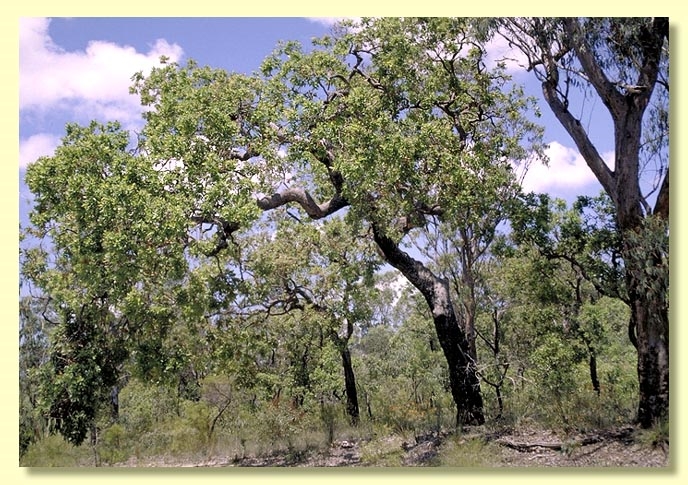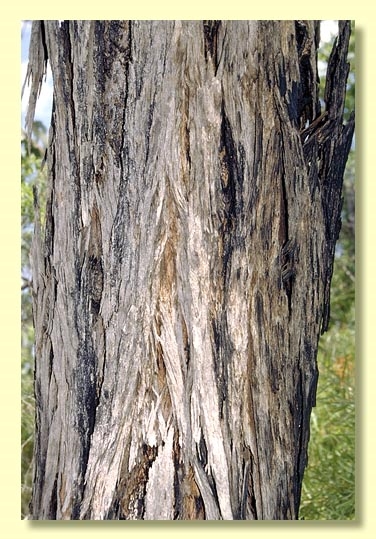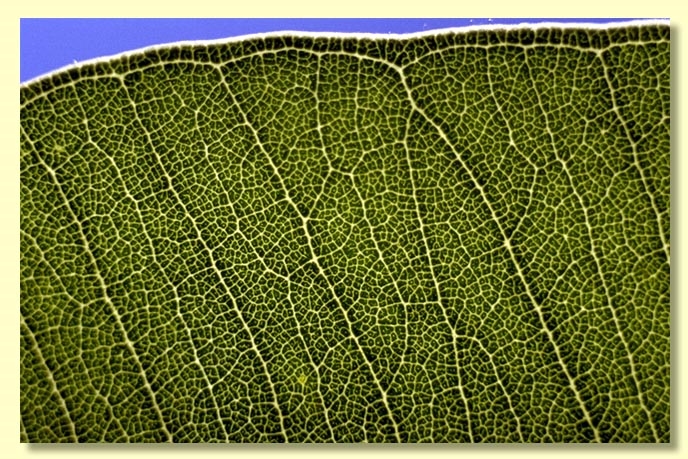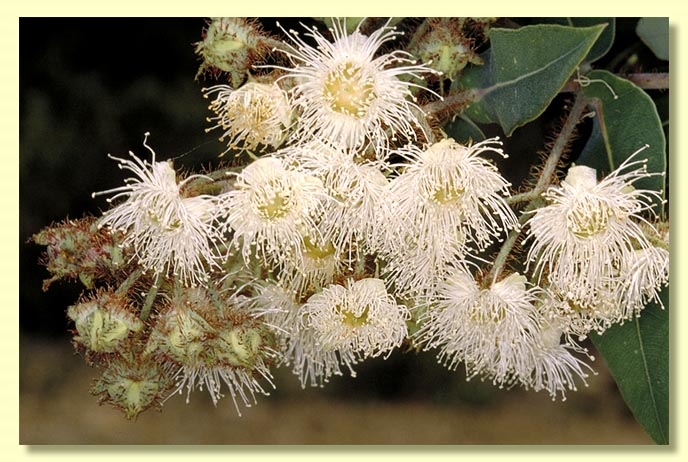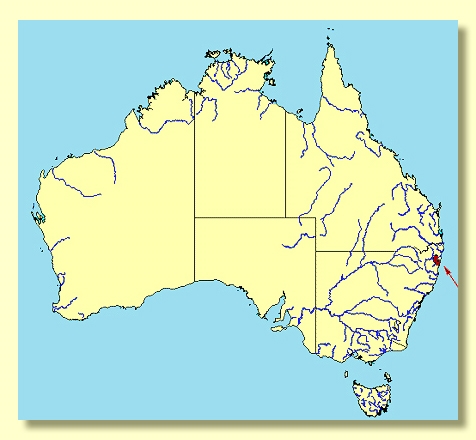Angophora
Euclid - Online edition
Angophora robur
Classification
Nomenclature
Description
Tree to 10 m tall. Forming a lignotuber.
Bark rough to the small branches, fibrous, grey to grey-brown. Glands (or ducts) sometimes present in the pith but only seen just below the nodes on young branchlets.
Juvenile growth (coppice or field seedlings to 50 cm): stem rounded in cross-section, pubescent; juvenile leaves opposite, sessile, lanceolate to oblong, 8–15 cm long, 2–5 cm wide, base amplexicaul, margin entire, apex acute, green, pubescent or glabrous.
Adult leaves opposite, usually sessile, rarely shortly petiolate, petioles 0–0.2 cm long; blade lanceolate to ovate to oblong, 6–18 cm long, 2.5–6 cm wide, flat or undulate, base amplexicaul or lobed, margin entire, apex acute, discolorous, glossy green to dull grey-green, penniveined, very densely reticulate, intramarginal vein present, oil glands small, island or obscure.
Inflorescence terminal compound, peduncles 1.5–3.5 cm long, buds 3 or 7 per umbel, pedicellate (pedicels 0.8–2.3 cm long). Mature buds globular (0.7–1 cm long, 0.7–1.2 cm wide), hypanthium pubescent, longitudinally ribbed, petals white with a green keel, stamens inflexed, anthers oblong, versatile, dehiscing by longitudinal slits (non-confluent), style long, stigma blunt, mop-like, locules 3 or 4, the placentae each with 5 vertical ovule rows. Flowers white or creamy white.
Fruit pedicellate (pedicels 1.6–2.2 cm long), cup-shaped to campanulate, 1.2–1.7 cm long, 1.2–1.6 cm wide, longitudinally ribbed, disc descending, valves 3 or 4, enclosed.
Seeds reddish brown to brown, flattened-ellipsoidal, dorsal surface smooth, hilum ventral.
Cultivated seedlings (measured at ca node 10): not grown yet.
Bark rough to the small branches, fibrous, grey to grey-brown. Glands (or ducts) sometimes present in the pith but only seen just below the nodes on young branchlets.
Juvenile growth (coppice or field seedlings to 50 cm): stem rounded in cross-section, pubescent; juvenile leaves opposite, sessile, lanceolate to oblong, 8–15 cm long, 2–5 cm wide, base amplexicaul, margin entire, apex acute, green, pubescent or glabrous.
Adult leaves opposite, usually sessile, rarely shortly petiolate, petioles 0–0.2 cm long; blade lanceolate to ovate to oblong, 6–18 cm long, 2.5–6 cm wide, flat or undulate, base amplexicaul or lobed, margin entire, apex acute, discolorous, glossy green to dull grey-green, penniveined, very densely reticulate, intramarginal vein present, oil glands small, island or obscure.
Inflorescence terminal compound, peduncles 1.5–3.5 cm long, buds 3 or 7 per umbel, pedicellate (pedicels 0.8–2.3 cm long). Mature buds globular (0.7–1 cm long, 0.7–1.2 cm wide), hypanthium pubescent, longitudinally ribbed, petals white with a green keel, stamens inflexed, anthers oblong, versatile, dehiscing by longitudinal slits (non-confluent), style long, stigma blunt, mop-like, locules 3 or 4, the placentae each with 5 vertical ovule rows. Flowers white or creamy white.
Fruit pedicellate (pedicels 1.6–2.2 cm long), cup-shaped to campanulate, 1.2–1.7 cm long, 1.2–1.6 cm wide, longitudinally ribbed, disc descending, valves 3 or 4, enclosed.
Seeds reddish brown to brown, flattened-ellipsoidal, dorsal surface smooth, hilum ventral.
Cultivated seedlings (measured at ca node 10): not grown yet.
Flowering Time
Flowering has been recorded in December.
Notes
Angophora robur is a small tree with a straggly habit occurring from north-west of Coffs Harbour, around Glenreagh, to north-west of Grafton. It belongs in the group which is diagnosed by the rough bark and the ± sessile leaves of the adult plant. The other members of this group are A. subvelutina and A. hispida.
A. subvelutina has smaller, softer leaves than A. robur and smaller buds and fruit, and occurs in subcoastal New South Wales north from Araluen in the southern ranges to the Northern Tablelands. A. hispida has a similar small habit to A. robur but differs only slightly by having slightly smaller leaves with normally rounded tips. A. hispida is a coastal species occurring in New South Wales from Sydney north to Gosford.
A. robur is listed as "Vulnerable" under the Australian Government Environment Protection and Biodiversity Conservation Act 1999 (EPBC Act). Further information may be found at this web address:
http://www.environment.gov.au/cgi-bin/sprat/public/sprat.pl
MORE ABOUT ANGOPHORA
A. subvelutina has smaller, softer leaves than A. robur and smaller buds and fruit, and occurs in subcoastal New South Wales north from Araluen in the southern ranges to the Northern Tablelands. A. hispida has a similar small habit to A. robur but differs only slightly by having slightly smaller leaves with normally rounded tips. A. hispida is a coastal species occurring in New South Wales from Sydney north to Gosford.
A. robur is listed as "Vulnerable" under the Australian Government Environment Protection and Biodiversity Conservation Act 1999 (EPBC Act). Further information may be found at this web address:
http://www.environment.gov.au/cgi-bin/sprat/public/sprat.pl
MORE ABOUT ANGOPHORA
Origin of Name
Angophora robur: Latin for oak, referring to the spreading appearance of the trees.
Copyright © CANBR 2020, all rights reserved.

Web edition hosted at https://apps.lucidcentral.org/euclid
